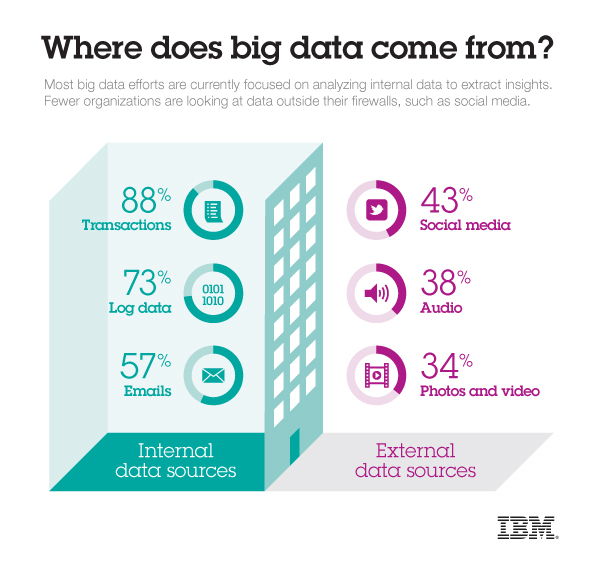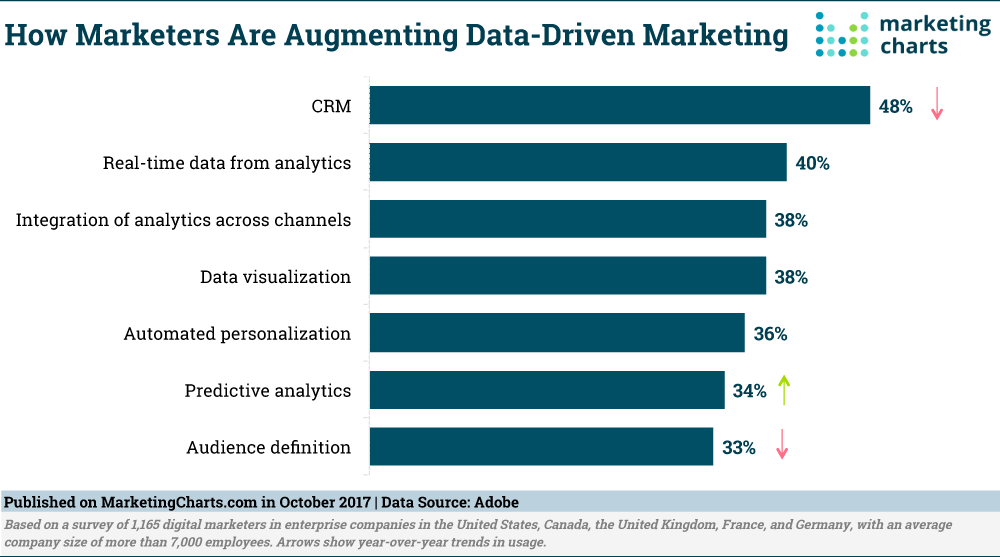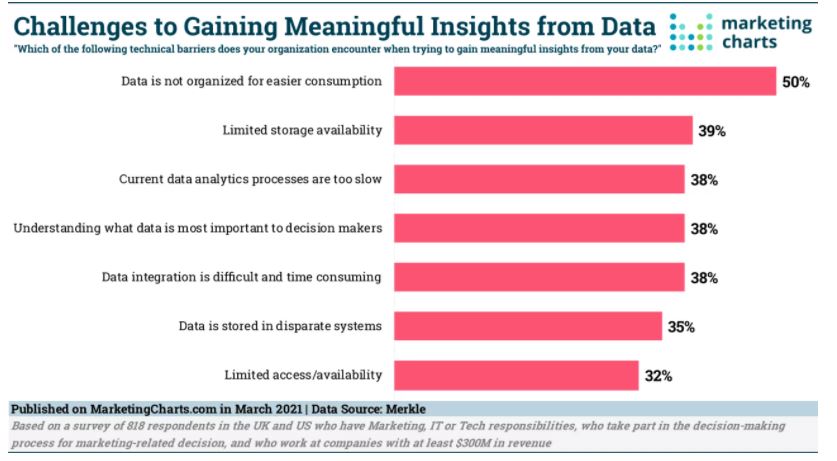How to Create and Use Actionable Insights for Business Growth
Collecting the right data and deriving actionable insights will help you create a competitive advantage and help your business grow.

Having access to relevant and accurate actionable insights is becoming increasingly important for companies of all sizes.
Detailed market intelligence and customer data are getting more accessible and affordable every year, so more and more businesses are deciding to invest in these areas.
This simply means data will become crucial for anyone trying to stay competitive. But it’s not just about collecting and storing raw data. Billions of disparate data points that you have to handle can’t be useful at all if they’re not properly processed and interpreted. In fact, this amount of data can easily misdirect you or confuse you, preventing you from making informed business decisions.
So first you’ll need to establish the context for the data, as well as to understand the key connections between sets of data points. Only then do you have a chance to gain insights that can actually be acted upon – hence the name actionable insights.
1. What are actionable insights?
First of all, it’s important to make a difference between three distinct concepts: data, information, and insight.
Data comes in a raw, unprocessed form. Data points represent particular measurable facts without necessarily assuming any connections between them.
Information contains a bit more. It’s data that’s processed and organized, and it provides an understanding of basic connections and trends. These data are systematized and arranged in a practical and straightforward way that offers a great starting point for deeper analysis.
Insights happen when thorough, comprehensive knowledge of the context comes into play. They are a result of detailed analysis of information and they lead to useful conclusions. And as we mentioned, if there’s a way to act upon these insights, we call them actionable.
An actionable insight example
We’ll try to clarify these differences further by using an example. Let’s say you own a company and you calculate your revenue at the end of every month. The fact that your company earned 50K on a certain month is what we denote as data.
Now, if you take your monthly revenues in the last 5 years, and arrange this data chronologically in order to recognize trends and tendencies, what you end up with is information. Noticing a steep drop in revenue in the last 18 months would be an example of this.
But the key step is yet to come. Once you start identifying the reasons for the trends you’ve noticed, using your knowledge of the context, you’ll get insights. Discovering that the fall in revenue correlates with the pandemic breakout, supply chain issues, or innovative breakthroughs by your competition – all these are insights. An insight is actionable if it suggests what the company should do in order to improve its position given the circumstances.
In short, there’s a whole spectrum here, with raw data at one end of it and insights at the other. The key question that arises is how to turn data into actionable insights and use them to your advantage?
2. Collecting the right data
Choose the relevant data sets
The amount of data you could collect to improve your business is virtually limitless. So here, sifting through is crucial. Most of the estimates claim that we produce more than 2.5 quintillion bytes of data every day. Companies use data analysis software of all kinds not just to collect immense volumes of data, but also to choose data sets relevant for their business needs.
Of course, the processing power of these software becomes bigger and bigger, but so does the amount of available data. If you don’t discriminate and just delve into the analysis of every piece of data you can lay your hands on, this will demand an awful lot of processing power, and, more importantly, it will probably leave you confused and unable to make any sense out of it.
Set some ground rules
So before data starts pouring in, you need to set some constraints. In this sense, data analysis is a somewhat predictive activity. You need to assume in advance which factors and parameters will lead you to worthy conclusions. Even sketching particular outcomes beforehand is welcome. You ought to choose which data to collect based on your expectations and ultimate goals and then see if the data proves you right or wrong.
There’s no recipe for success here, but a typical rule of thumb should be whether collecting a certain type of data will add any value to your operation. It’s key that you create proper filters that will let you focus on what’s really essential.
Use the right tools
The other key is technology. There’s a vast number of data sources you can use, so make sure you get hold of accurate and relevant ones.
Probably the most useful ones are those that analyze your particular audience and customers, such as social media analytics or CRM software that keeps track of your website activity. Integrating all these different sources into a solid, unified body of data is also critical if you wish to move forward to the next steps.
3. Turning data into insights
Connecting the dots
Once you got that sorted out, it’s time to put all these disparate bits of data into context and draw conclusions. Remember, an insight is a piece of info that’s complex and structured, yet clear and specific. It needs to be relevant and bring you closer to actually understanding the issue you’re dealing with.
Firstly, data needs to be transformed into information. This is done by prioritizing, sorting, segmenting, and grouping huge numbers of data points.
Most of this work is automated and based on the initial rules and criteria that you set. And when you’re setting these rules, remember that balance is critical here. If you’re being too general, your findings may turn out to be empty and superficial, and yet if you’re being too specific this can confuse you, overwhelm you, or simply make you lose sight of the bigger picture.
Assemble a versatile team
Keep in mind that this initial algorithm may need to be modified if circumstances change radically. In times of turmoil and dramatic market fluctuations like the one we live in right now, some info may cease to be relevant, while some other might gain importance.
That’s why it’s very valuable to have a wide range of professionals to help you interpret the results. It’s not just about data scientists, but also marketers, financial experts, salespeople, customer service reps, market specialists, basically anyone who can chip in with their 2 cents and their knowledge about a certain sphere of your business or your market.
If you assemble a competent team, it will be easier to distinguish between causation and mere accidental correlations. There are a lot of moving parts and you need people who actually understand how specific different parts move and what causes them to change in order to avoid misinterpretations.
Use visualization
Finally, the way you present the obtained information is crucial. It’s much easier to read and understand well-designed, user-friendly visualizations than infinite monotonous spreadsheets.
This part of the work can also be automated, and a quality reporting tool can do wonders for you here. It can extract raw data from your data sources and organize it to create easy-to-understand charts and graphs based on the presets you’ve prepared.
4. Enabling actionable insights
Connecting insights and actions
So you got your data, you got your software, a capable team to make sense of the data and you managed to gain valuable actionable insights about what’s good and what’s bad for your business. The process is still far from over though.
Sometimes it seems that acting upon the gathered intelligence may be the trickiest bit. Research by Forrester shows that 74% of firms want to be data-driven, but only as little as 29% of them think they are good at connecting analytics to action.
Discover How SpotlerCRM Can Help
Human role in decision-making
Note that the development of new technologies can only partially fix this problem, as at least a part of the decision-making process has to be done by humans. Admittedly, software is becoming better at predicting future trends and even making some particular decisions themselves.
But on the other hand, the big decisions about the overall business strategy, brand management, or a PR crisis either have too many variables or simply aren’t quantifiable.
For instance, you can measure how much money your company will lose due to certain decisions during a PR crisis, but you can’t strictly measure “how much reputation” it will lose. And even if you could, deciding “how much” of the reputation a company is ready to lose is based on typically human goals and aspirations, and not exclusively driven by financial logic.
Is it even worth it?
Hence in order to properly act upon insights, you need everything: reliable data, experts who can analyze it, software that can generate solid predictions, and human decision-makers who determine the future actions while keeping a bigger picture in mind.
It’s a very complex process, and to truly grow your business, you’ll have to get everything right. And it’s worth it. That’s why as much as 77% of companies in the US and 69% in the UK are data-driven, while insights-driven businesses are generally growing at a rate of more than 30% each year. And properly turning raw unstructured data into actionable insights is the absolute key once you decide to take this road.
5. Final thoughts
Getting your business to become data-driven can be a frightening experience. It’s a huge shift, especially for old school owners and executives. It’s also risky and complicated and the whole thing may just seem too obscure and confusing. So it’s not a surprise if executives get nervous when trying to implement changes that will make their companies more data-driven.
Collecting tons of disparate data and deriving actionable insights from them may seem like an awful lot of work, but it’s really the only way. You will make some mistakes along the way, and you’ll have to update algorithms, tinker with pre-set criteria, and adapt to new circumstances all the time.
But with the right approach and a capable team, you’ll be making fewer and fewer mistakes, you’ll gain confidence and experience, and in the long run, you’ll be able to use data to create a competitive advantage and help your business grow.
Really Simple Systems is now Spotler CRM
The same great technology, a CRM platform that is focused on the needs of B2B marketers, provided by the same great team, at a great price!



